Imagine stepping into a living room that feels like an oasis of calm and natural beauty—this is the essence of organic modern design. Combining earthy materials with sleek, contemporary aesthetics, organic modern living rooms are increasingly popular for their ability to create welcoming, serene environments that breathe life into any space.
In this article, you’ll uncover a variety of inspiring ideas that blend natural textures, sustainable materials, and minimalist decor to craft your perfect organic modern living room. Whether you’re drawn to warm wood accents, lush greenery, or neutral color palettes, these ideas will help you infuse your home with authentic comfort and style.
1. Embrace Neutral Color Palettes with Warm Tones for a Cozy Atmosphere
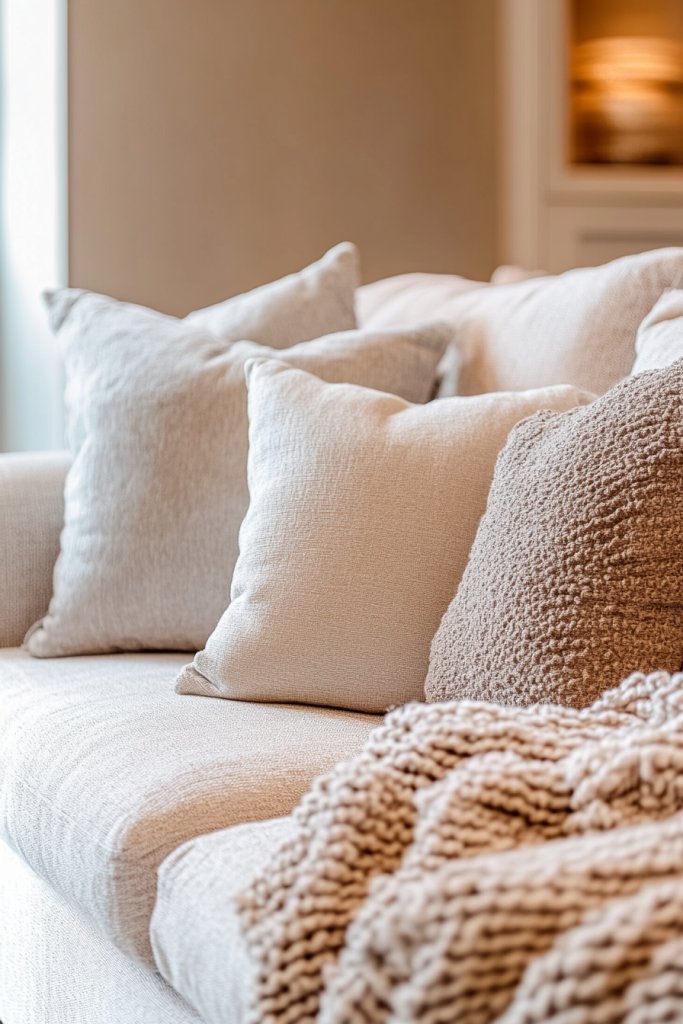
Ever feel like your living room lacks that warm, inviting vibe? Maybe your space looks a bit dull or sterile, making it hard to unwind after a long day. Everyone craves a cozy atmosphere where they can truly relax and feel at home. The good news? The right color palette can completely transform your space into a sanctuary.
Picture walls painted in soft creams, warm beiges, and gentle taupes. Textures like plush throws and soft rugs in earthy hues add depth and comfort. Think of a cozy nook with a gentle amber glow from natural light bouncing off warm-toned walls. This palette creates a soothing backdrop that makes your furniture and decor pop without overwhelming the senses.
You can tweak the warmth depending on your style—more muted tones for a Scandinavian vibe or richer shades for a rustic feel. During winter, layer in deeper hues like cinnamon or burnt orange for extra warmth. In summer, lighten the palette with sandy beiges and off-whites for a breezy feel. The key is balancing these tones with textured accessories.
Start by choosing a neutral base—think beige or soft gray walls. Add warmth with textiles like a cozy wool throw or a velvet cushion in amber. Incorporate furniture in natural wood tones or matte finishes. Use warm LED lighting to enhance the cozy effect, avoiding harsh fluorescent bulbs. Keep your decor minimal to let the tones breathe and create a peaceful vibe.
Personalize by adding throw blankets in textured fabrics like chenille or boucle. Incorporate candles in amber or terracotta holders for a soft glow. Mix and match warm-toned cushions and curtains to create layers of comfort. Small decorative items in earthy colors also help tie the look together. Remember, your space should reflect your personality—so choose shades that resonate with you.
A warm, neutral palette isn’t just trendy; it’s timeless. It creates a peaceful environment that encourages relaxation and connection. With a little effort, you can craft a space that feels like a warm hug every time you walk in. Ready to embrace these tones and make your living room irresistibly cozy?
2. Incorporate Sustainable, Reclaimed Wood Furniture for Eco-Friendly Charm
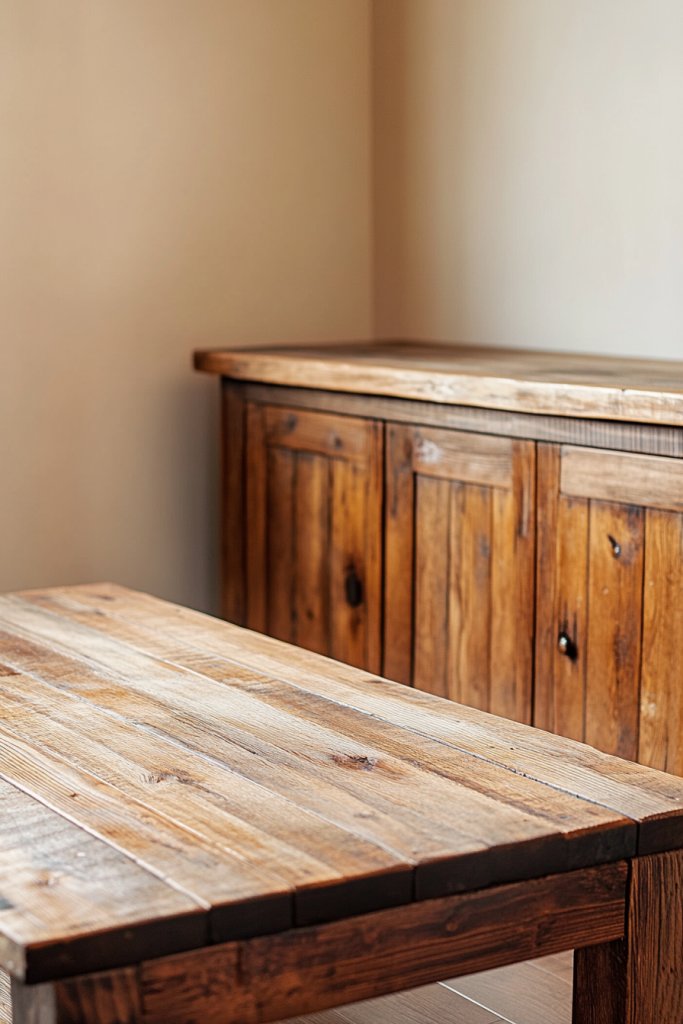
Feeling guilty about contributing to deforestation while styling your home? Want furniture that looks good and helps the planet? Reclaimed wood offers a stylish, eco-friendly solution that doesn’t sacrifice character for sustainability. Plus, it adds a rustic charm that’s hard to replicate with new materials.
Imagine a coffee table with rich, weathered grain and imperfect edges that tell stories of its past life. Or a bookshelf with mismatched, vintage planks that add personality and warmth. The natural textures and knots in reclaimed wood create a tactile experience, making your space feel grounded and authentic. The aged patina adds depth and character, turning your living room into a curated gallery of history.
Reclaimed wood works with various styles—from farmhouse and industrial to boho chic. For a minimalist look, opt for sleek, simple pieces that highlight the natural imperfections. During different seasons, pair it with cozy textiles or metallic accents for contrast. You can also combine reclaimed wood with modern materials like black metal for a balanced aesthetic.
Start by sourcing reclaimed wood from local suppliers or salvage yards. Look for pieces with minimal damage but unique character. Decide on key furniture pieces like a coffee table, side tables, or shelves. Finish with natural oils or waxes to protect the wood and enhance its grain. Be prepared for some assembly and perhaps light sanding to smooth rough edges.
Personalize with handcrafted details—like custom carved handles or painted accents on reclaimed wood furniture. Add woven baskets or fabric-lined drawers to increase functionality. Mix different wood tones for a layered, eclectic look. Keep the finish natural or experiment with light stains for a custom touch that highlights the wood’s history.
Using reclaimed wood is a sustainable choice that adds genuine character to your space. It’s a statement that eco-conscious living can be stylish and sophisticated. With a little effort, you’ll create a warm, inviting living room that’s both beautiful and good for the planet. Ready to give reclaimed wood a try?
3. Use Textured Natural Fabrics Like Linen and Wool for Soft, Inviting Surfaces
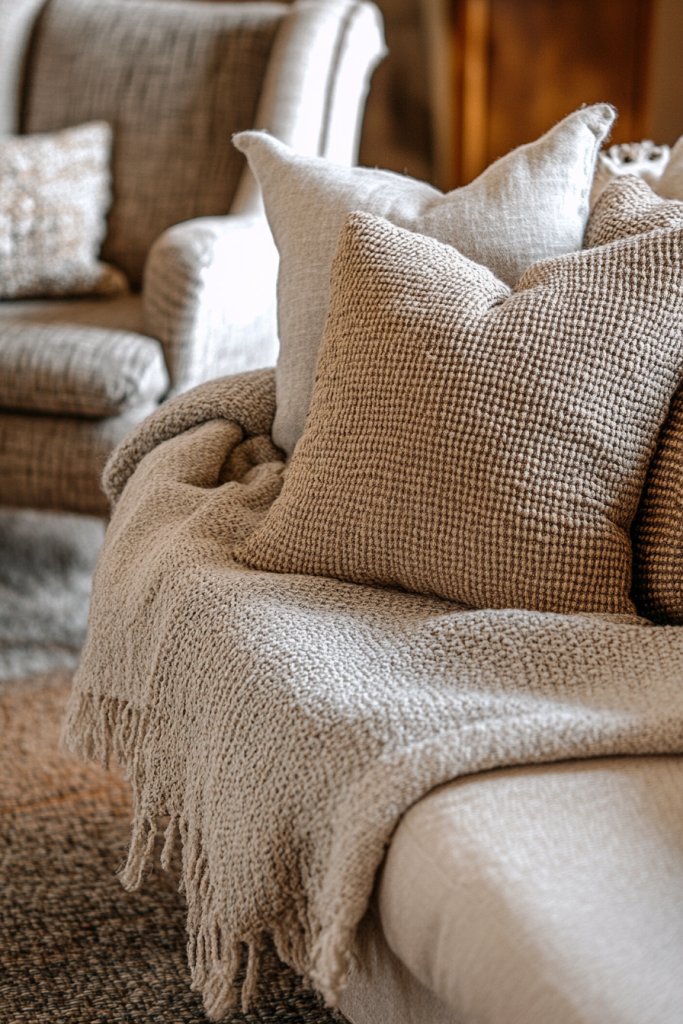
Does your living room feel flat or uninspired? Maybe the surfaces lack that soft, inviting touch that makes you want to sink into comfort. Textured fabrics like linen and wool can instantly add a cozy layer that invites relaxation. Plus, they bring visual interest and tactile richness to your decor.
Envision a plush wool throw draped over a sofa or linen cushions in earthy tones scattered across a neutral sofa. The rough yet refined textures catch the light and invite touch. Imagine soft, natural fibers that add depth to plain surfaces, creating a layered, tactile experience. These fabrics soften the overall look while adding warmth and comfort.
Mix textures for a curated look—pair smooth linen with chunky knits or soft wool. For summer, lightweight linen keeps the space fresh; in winter, layer with heavy wool blankets or throws. Use textured fabrics in upholstery, pillows, or curtains to add warmth without overwhelming the space. Adjust colors to match seasonal palettes for a cohesive look.
Choose high-quality linen and wool fabrics in natural shades. Use linen for curtains or slipcovers, and wool for throws or cushions. Incorporate these textiles into your furniture choices or as decorative accents. Regular care involves gentle washing and avoiding harsh chemicals to keep their natural beauty. Layering different textures creates visual depth and comfort.
Add embroidered or woven details to your textiles for a personal touch. Experiment with color accents through dyed wool or patterned linen. Incorporate tactile elements like fringe or tassels to enhance the handmade feel. Swap out textiles seasonally to keep the space feeling fresh and inviting.
Natural fabrics like linen and wool are timeless classics that never go out of style. They create a warm, inviting environment that feels lived-in yet refined. With simple layering and thoughtful choices, you can craft a living room that’s both beautiful and irresistibly cozy.
4. Optimize Natural Light with Large Windows and Minimal Window Treatments
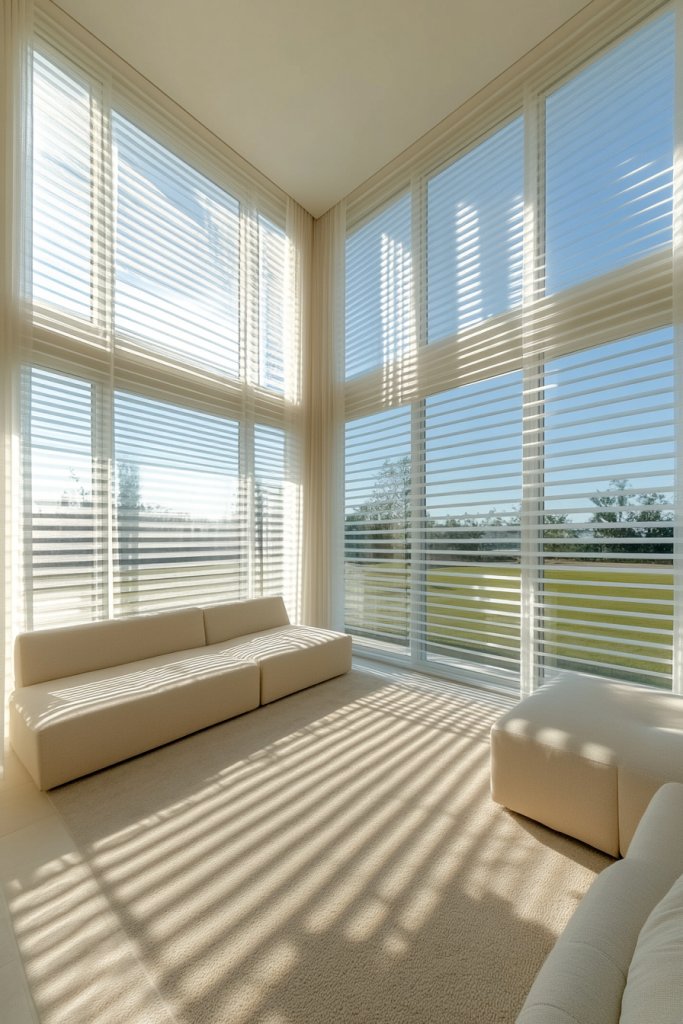
Ever notice how a room feels gloomy or closed off? Natural light is the ultimate mood booster, making your space feel bigger, brighter, and more welcoming. But heavy curtains or small windows can block that sunshine and dampen the vibe. Letting light flood in can completely change your living room’s energy.
Imagine a wall of floor-to-ceiling windows with sheer, airy curtains that flutter with the breeze. The sunlight dances across neutral walls and textured rugs, creating a lively yet calming atmosphere. Minimal window treatments allow the outside in, emphasizing views and connecting your indoors with nature. Bright, natural light enhances every surface and color, making your space feel alive.
Opt for large, unobstructed windows whenever possible. Use light, translucent curtains or simple blinds that can be fully drawn back. For privacy, consider frosted or textured glass that diffuses light without blocking it. Adjust window treatments seasonally—lighter fabrics in summer, layered options in winter.
Start by evaluating your current window sizes and placements. If remodeling, opt for expansive glass panels or large frames. Choose minimalistic treatments like roller shades or linen curtains that can be easily pulled aside. Keep window sills clear of clutter to maximize light flow. Use light-colored walls and reflective surfaces to bounce light deeper into the room.
Enhance natural light with strategically placed mirrors to reflect sunlight. Use textured or patterned sheer curtains to add visual interest without blocking light. Install blackout shades only for nighttime or movie nights, keeping most of the day’s light unobstructed. Personalize with subtle tiebacks or decorative rods that blend seamlessly into your decor.
Maximizing natural light creates a vibrant, energetic environment that lifts your spirits. It’s an effortless way to make your living room feel more spacious and connected to the outdoors. Embrace the sunshine and let your space shine—literally!
5. Install Open Shelving with Earth-Tone Decor to Showcase Simplicity and Functionality
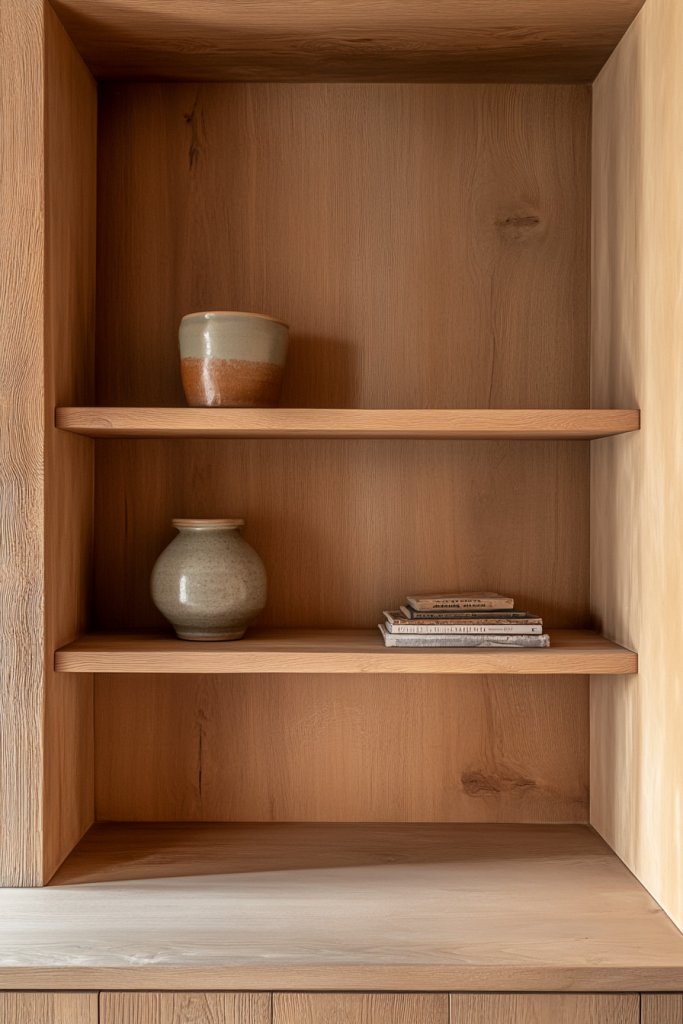
Cluttered shelves and closed cabinets can make your living room feel cramped and chaotic. Craving a stylish way to display your essentials while keeping things accessible? Open shelving offers a perfect blend of function and minimalism. Plus, it allows you to showcase your favorite textures and tones effortlessly.
Picture sleek wooden shelves in warm, earthy hues mounted on a neutral wall. They hold a curated mix of books, ceramics, and woven baskets—nothing too fussy, just enough to keep things interesting. The open design creates a sense of spaciousness, while the earth-tone decor grounds the space with warmth. Soft lighting highlights the layered arrangement, adding depth.
Choose floating or ladder-style shelves based on your space and style preference. For a minimalist look, stick to a neutral palette; for more personality, incorporate textured or patterned items in muted tones. Shelves can be arranged asymmetrically for a modern edge or symmetrically for a classic look. Mix functional storage with decorative pieces for versatility.
Select sturdy, natural wood or matte-finish shelving units. Mount them securely at eye level or higher for visual balance. Arrange your items in a balanced yet dynamic way, combining height, texture, and color. Use hidden brackets or wall anchors for a clean look. Keep clutter to a minimum to preserve the simplicity.
Personalize with handcrafted ceramics, textured baskets, or vintage finds in earthy colors. Incorporate small sculptures or sculptural objects to add visual interest. Use baskets or containers to keep smaller items organized and tidy. Update your shelf styling seasonally for fresh appeal.
Open shelving in earthy tones elevates your decor while keeping things functional. It’s a practical way to showcase your personality and style. With a little planning, you can create a visually appealing, clutter-free living space that feels warm and inviting.
6. Add Layered Rugs in Jute, Sisal, or Wool to Create Warm, Textured Zones
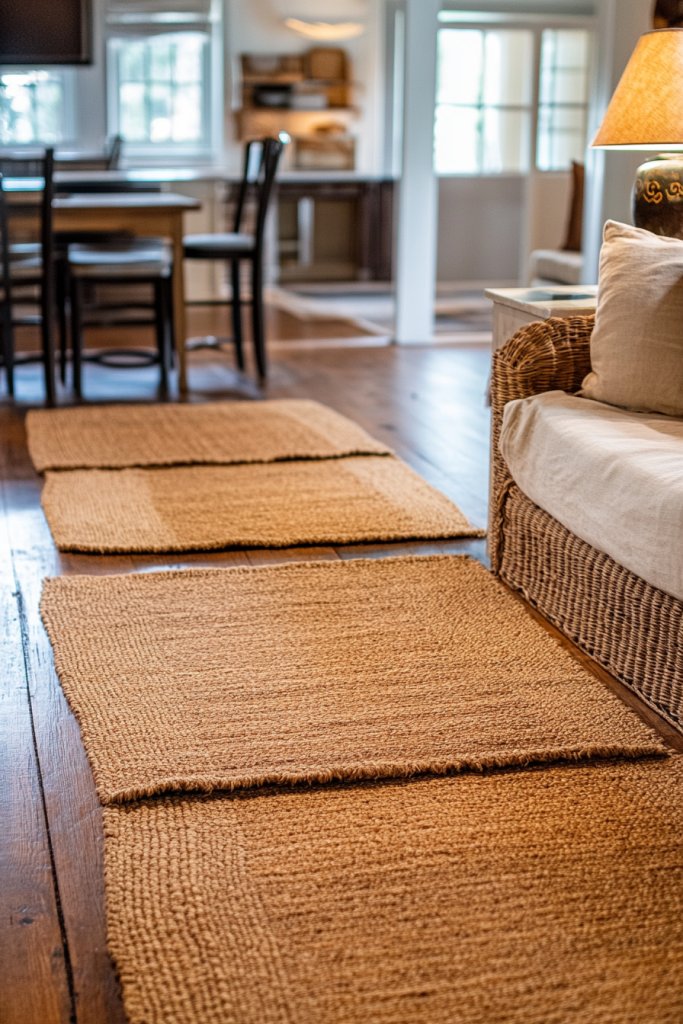
Does your living room lack that cozy, defined feel? Maybe it’s all one big open space that’s hard to anchor visually. Layered rugs in natural textures can create distinct zones, add warmth, and bring tactile richness. They also help soften hard floors and make your space more inviting.
Imagine a large jute rug layered with a smaller wool rug in a complementary tone. The textures vary from rough to soft, creating visual and tactile interest. You feel the natural fibers underfoot, and the layered look introduces depth and dimension. It’s like giving your space a cozy, handcrafted vibe that invites relaxation.
Mix different natural fibers—jute, sisal, wool—for a textured, layered effect. Use neutral tones or subtle patterns for a cohesive look. Change the layering arrangement seasonally or based on activity zones, like a reading corner or conversation area. Keep the rugs proportionate to the space for balance.
Start with a large base rug in a natural fiber, then add smaller rugs on top. Ensure rugs are sturdy and easy to clean, especially in high-traffic areas. Use non-slip pads underneath to prevent slipping and bunching. Layering can be done asymmetrically or symmetrically, depending on your style. Regular maintenance keeps the fibers looking fresh.
Incorporate fringed or tasseled edges for extra texture. Use rugs with subtle patterns or natural dyes to add visual interest. Add a few plush cushions or poufs nearby for extra comfort. Changing up the rug layers gives your room a fresh feel without major overhaul.
Layered rugs are a simple, effective way to add warmth and personality to your living room. They create cozy zones perfect for lounging or entertaining. With a little effort, you can craft a textured, inviting space that feels both stylish and lived-in.
7. Choose Minimalist, Low-Profile Sofas with Organic Shapes for a Relaxed Feel
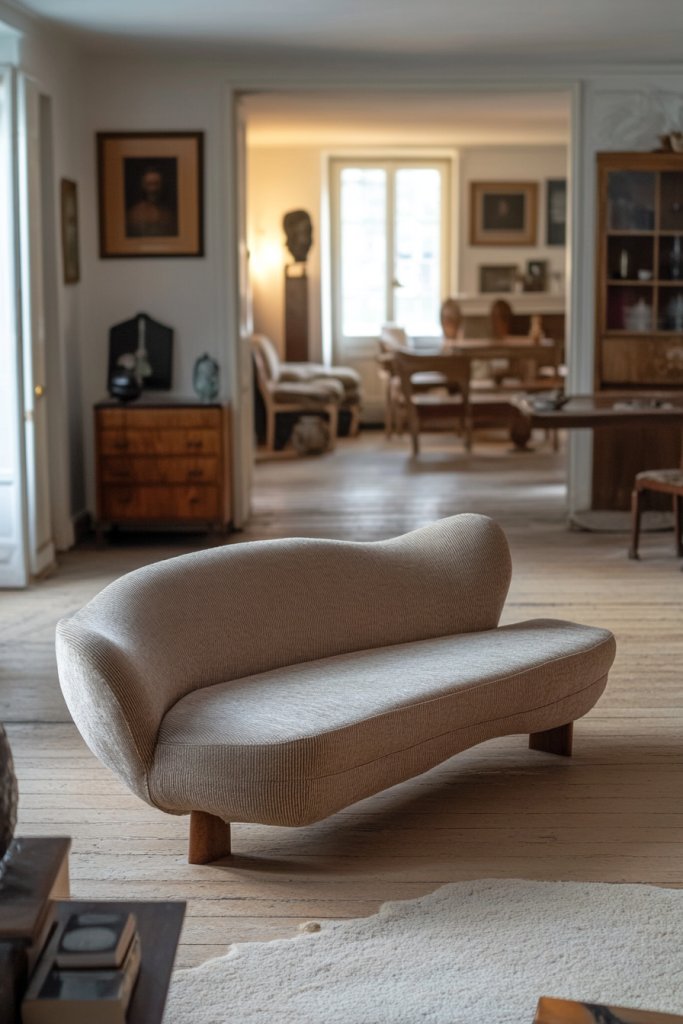
Longing for a living room that feels open and uncluttered? Overstuffed sofas can make a space look cramped and heavy. Minimalist, low-profile sofas with organic shapes offer a relaxed vibe and a sense of freedom. They invite you to kick back without feeling overwhelmed by furniture.
Picture a sleek, low-slung sofa with gently curved edges and a simple silhouette. The fabric is in a neutral, earthy tone, complementing the natural textures around it. The absence of bulky arms or high backs creates an airy, open feeling. Scatter a few textured cushions in muted hues for added comfort.
Opt for sofas in neutral or soft organic colors to blend seamlessly. Choose curved or rounded shapes for a more relaxed, inviting look. For small spaces, go for modular or corner options that maximize seating without crowding. Seasonally, layer with throws or cushions in textured fabrics for warmth.
Select a low-profile sofa with a simple frame and natural fabric upholstery. Prioritize comfort with supportive cushions and flexible seating options. Keep legs minimal or hidden to enhance the low-slung aesthetic. Place in an open area to maintain flow, and add a textured rug underneath for grounding.
Personalize with organic-shaped pillows or sculptural side tables made of natural materials. Use throws in textured fabrics like boucle or woven wool to add softness. Mix and match with other furniture pieces that share the organic, minimalist vibe. Keep clutter minimal to preserve the relaxed feel.
A minimalist, organic-shaped sofa fosters a sense of calm and openness. It’s a timeless choice that adapts to any decor style, from modern to rustic. With simple, thoughtful additions, your living room becomes a sanctuary of comfort and style.
8. Use Handmade Ceramics and Vessels as Subtle Decorative Accents
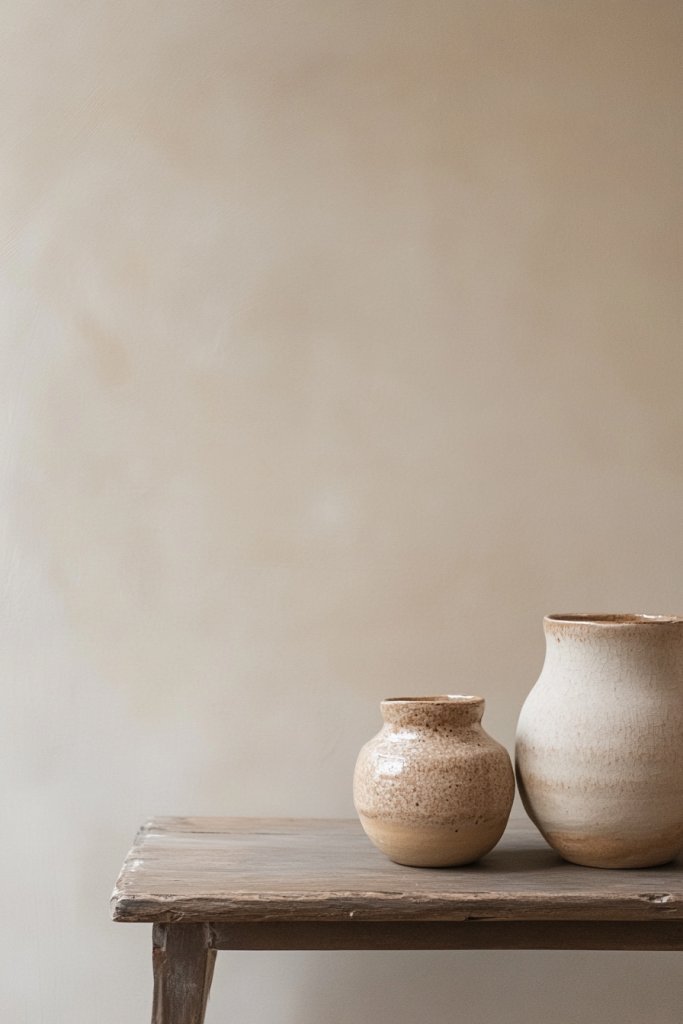
Tired of overstuffed decor that feels cluttered? Want to add subtle, artistic touches that elevate your space? Handmade ceramics and vessels can serve as understated accents that bring character without overwhelming. They’re perfect for adding a crafted feel to your organic modern living room.
Imagine a collection of irregularly shaped ceramic bowls and vases in earthy tones, displayed on open shelves or side tables. The textures range from matte to glossy, each piece telling its own story. These vessels add visual interest and a handcrafted touch that makes your space feel curated and unique.
Arrange ceramics in groups of odd numbers for a balanced look. Incorporate sculptural vessels in organic shapes or with subtle imperfections for authenticity. Use them as standalone pieces or to hold dried botanicals, which are eco-friendly and long-lasting. Change displays seasonally for fresh appeal.
Source handmade ceramics from local artisans or craft markets to ensure uniqueness. Place them on open shelving, coffee tables, or mantels. Keep their surfaces clean with gentle, non-abrasive cleaners. Mix different textures and shapes to create an artful, layered display that complements your decor.
Add personal touches with custom painted designs or initials. Incorporate textured glazes or natural finishes for added depth. Use ceramics of varying heights and shapes to create visual rhythm. Rotate pieces periodically to keep your display fresh and inspiring.
Handmade ceramics bring authenticity and craftsmanship into your home. They elevate simple surfaces into works of art and foster a sense of connection to artisans. With a few well-chosen pieces, you create a subtle yet impactful decor statement.
9. Incorporate Indoor Plants in Simple Containers to Enhance Natural Vibes
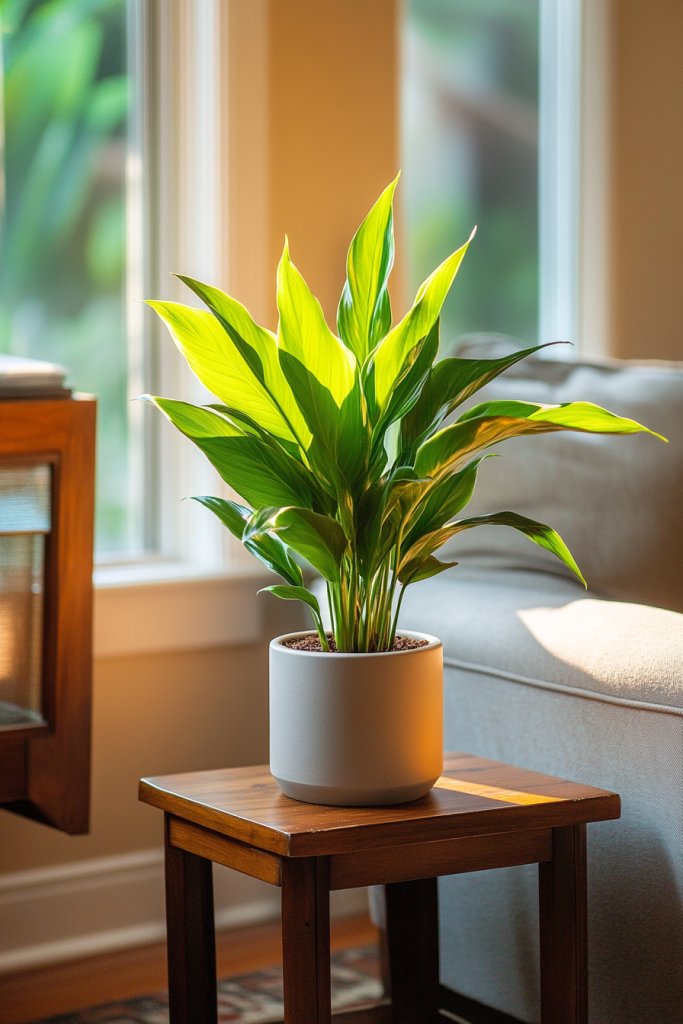
Want to bring a lively, fresh feel to your living room without clutter or fuss? While plants are popular, many struggle with green thumbs or maintenance. The trick is choosing simple containers that highlight the natural vibe without overwhelming the space. Fresh greenery can make your home feel vibrant and alive.
Imagine sleek, matte ceramic pots in earthy tones placed on floating shelves or coffee tables. The lush greenery adds a pop of color and texture, softening hard surfaces and creating a calming atmosphere. Sunlight filters through windows, illuminating the leaves and casting gentle shadows. The overall effect is organic and inviting.
Select low-maintenance, easy-to-care-for plants like succulents, pothos, or snake plants. Use minimalist containers in neutral colors or textured ceramics for contrast. Change plant arrangements seasonally or group different sizes for visual interest. Incorporate plant stands or hanging planters for vertical variation.
Choose containers made of natural materials like clay, ceramic, or bamboo. Position plants near windows or in well-lit areas, adjusting watering and care as needed. Group plants together for a mini indoor garden or scatter them across surfaces for a more dispersed look. Regularly dust leaves to keep them healthy and vibrant.
Personalize with decorative plant tags or painted pots for a custom touch. Use natural fiber hangers or woven baskets for added texture. Mix in dried botanicals or natural elements like stones or wood accents to enhance the organic feel. Rotate plants to maintain visual freshness.
Indoor plants boost air quality and mood while adding natural beauty. They’re an easy way to connect with nature inside your home. Start small, and soon you’ll be surprised how much life and calm they bring to your space.
10. Design with Modular, Multi-Functional Pieces for Practical Living Spaces
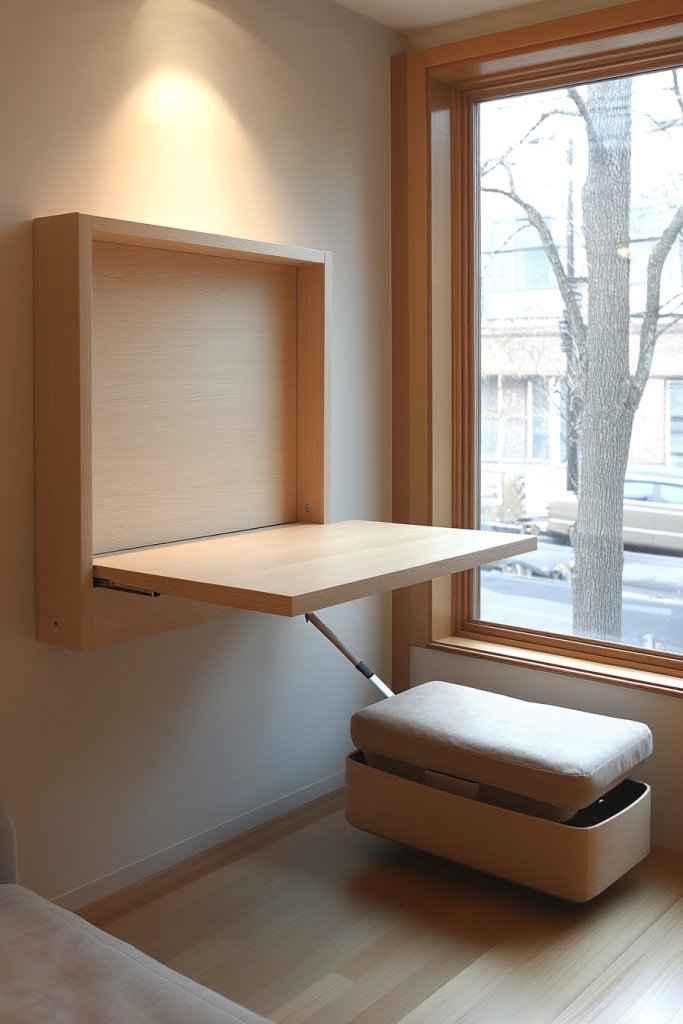
Limited space making your living room feel cramped? Want furniture that adapts as your needs change? Modular, multi-functional pieces are the answer. They maximize functionality without sacrificing style, making your space more flexible and efficient.
Picture a sleek sectional that can be rearranged into different configurations or a coffee table with hidden storage compartments. These pieces blend seamlessly into a modern aesthetic, offering versatility. The design emphasizes clean lines and neutral finishes to keep it feeling open and uncluttered. The furniture adapts to your lifestyle, whether hosting guests or relaxing solo.
Choose pieces with modular components that can be added or removed, like ottomans or extendable tables. Use neutral or monochrome finishes for a timeless look. For different seasons, add textured throws or decorative cushions for a cozy feel. Mix and match with shelving units or storage benches for a cohesive setup.
Start by assessing your space and listing your functional needs. Look for furniture with adjustable or movable parts—think fold-away beds, extendable tables, or storage-integrated seating. Use durable, lightweight materials for easy rearrangement. Establish a layout that encourages easy mobility and accessibility.
Add personal touches with textured cushions, throws, or decorative trays that can be swapped out seasonally. Incorporate smart storage solutions like hidden drawers or under-seat compartments. Keep the design minimalist to preserve an open feel. Regularly update accessories to keep the look fresh.
Modular furniture makes your living space work harder for you. It’s an investment in flexibility, style, and function. With thoughtful choices, your room can evolve effortlessly to suit your lifestyle, making every day more comfortable and organized.
11. Incorporate Natural Stone Elements in Flooring or Accent Walls for Texture
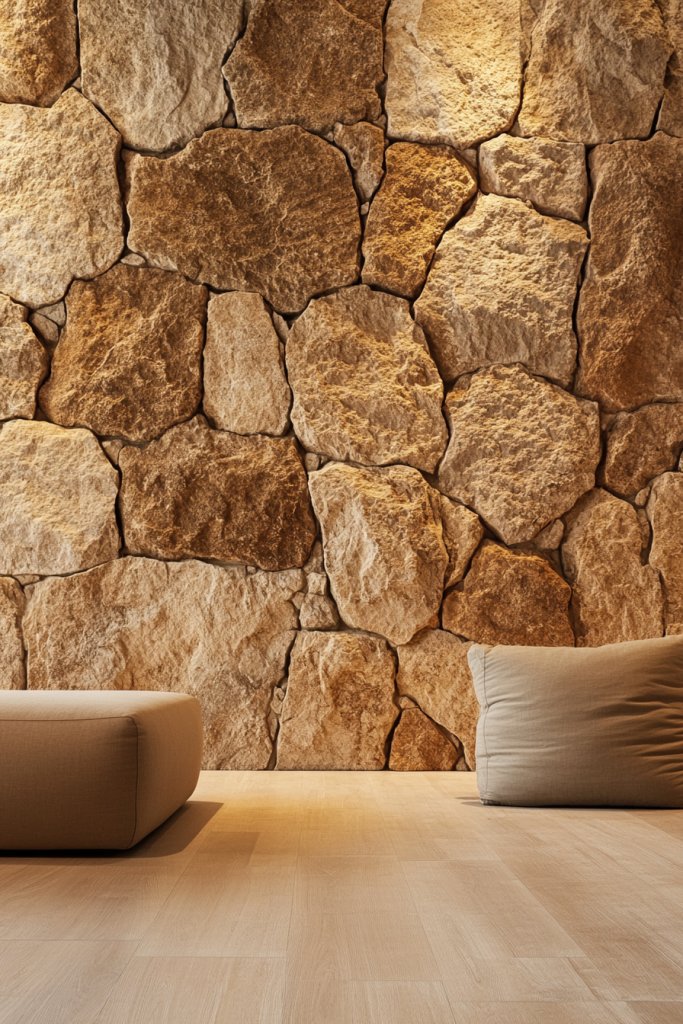
Feeling like your living room lacks texture and depth? Flat paint and smooth surfaces can leave a space feeling dull. Natural stone introduces rich texture and visual interest, elevating your decor while grounding the room. It’s a timeless way to add a touch of nature’s grandeur.
Imagine a feature wall clad in rough-hewn slate or smooth travertine tiles. The stone’s natural variations in color and texture create a dynamic backdrop that catches the eye. The floor features large, matte stone tiles that reflect light softly and add durability. The contrast between stone and soft textiles or wooden furniture creates a harmonious, organic vibe.
Use stone in small accent areas like fireplace surrounds or tabletops for subtle texture. Larger applications like flooring or full accent walls make a bold statement. Match the stone’s natural hues with your overall color palette—warm earth tones or cool grays work well. Combine with other natural materials for a layered, organic look.
Source quality natural stone from reputable suppliers. Decide whether to go for polished, tumbled, or rough textures based on your style. Hire experienced installers for large or complex projects. Prepare your space with proper subflooring or wall reinforcement. Seal the stone to protect it from stains and moisture, especially in high-traffic areas.
Add sculptural stone pieces or textured tiles in geometric patterns for visual interest. Incorporate subtle lighting to highlight the stone’s natural variations. Use natural fiber rugs or textiles to soften the hard surfaces. Keep maintenance simple with regular cleaning using gentle, stone-safe products.
Natural stone adds authentic texture and durability to your home. It creates a sophisticated, earthy ambiance that ages beautifully. With careful planning, you can incorporate this element seamlessly into your organic modern living room—making it feel both grounded and luxurious.
12. Install Recessed or Pendant Lighting with Warm LED Bulbs for Soft Illumination
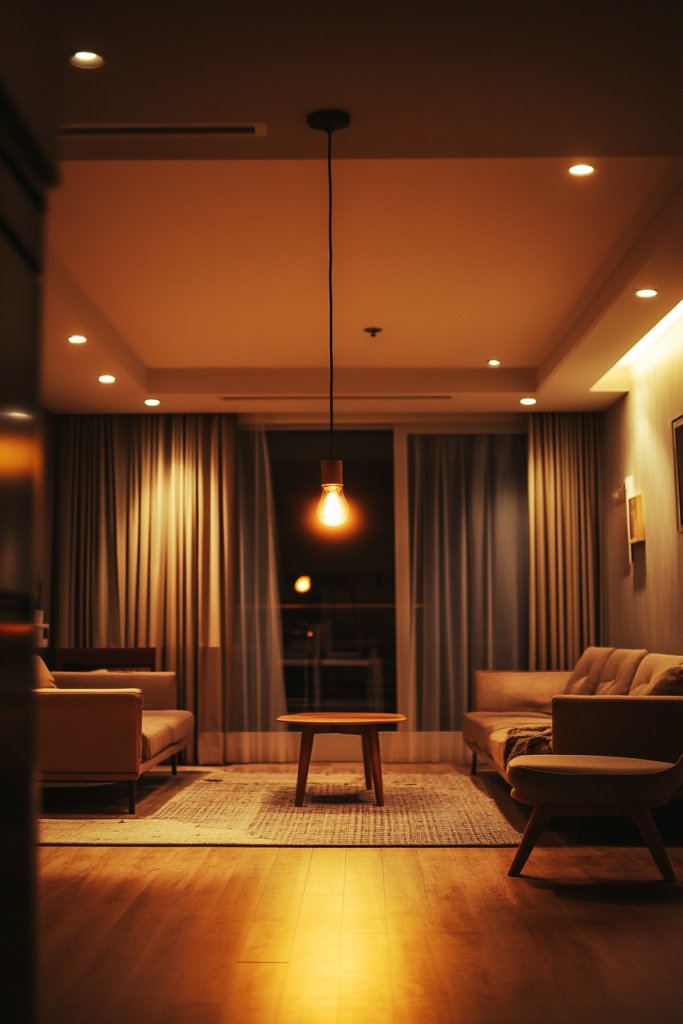
Is harsh overhead lighting killing the mood in your living room? Bright, cold lights can make spaces feel clinical and uninviting. Warm LED lighting creates a cozy, ambient glow that instantly transforms your space into a relaxing retreat. The right lighting can make everything feel more alive and welcoming.
Imagine subtle recessed lights woven into the ceiling, casting gentle pools of warm light across the room. Or slender pendant fixtures hanging low over a seating area, emitting a soft amber hue. The lighting accentuates textures and colors without overpowering the space. Shadows dance softly, adding depth and intimacy to your living environment.
Use dimmable lights to adjust the ambiance based on mood or activity. Combine recessed lighting with decorative sconces or LED strip lighting behind shelves for layered illumination. Choose fixtures in natural or matte finishes to keep the organic vibe. Seasonal changes, like candlelight or string lights, can add extra warmth.
Start with a lighting plan that emphasizes warm LED bulbs—look for color temperatures around 2700K. Install dimmer switches for adjustable brightness. For recessed lighting, hire a professional to ensure proper placement and wiring. Pendant lights should hang at eye level or slightly above for visual balance. Layer your lighting for a cozy, adaptable environment.
Add decorative fixtures with organic shapes or natural finishes. Incorporate soft-glow lamps or lanterns for additional warmth during evenings. Use lighting to highlight architectural features or textured walls. Regularly update bulbs and fixtures to keep your space fresh and inviting.
Thoughtful lighting enhances both the look and feel of your living room. It’s an easy upgrade that significantly boosts comfort and ambiance. Embrace layered, warm illumination to create a space that is both stylish and soothing—your perfect organic retreat.
13. Decorate with Organic-Shaped Mirrors to Add Light and Visual Depth
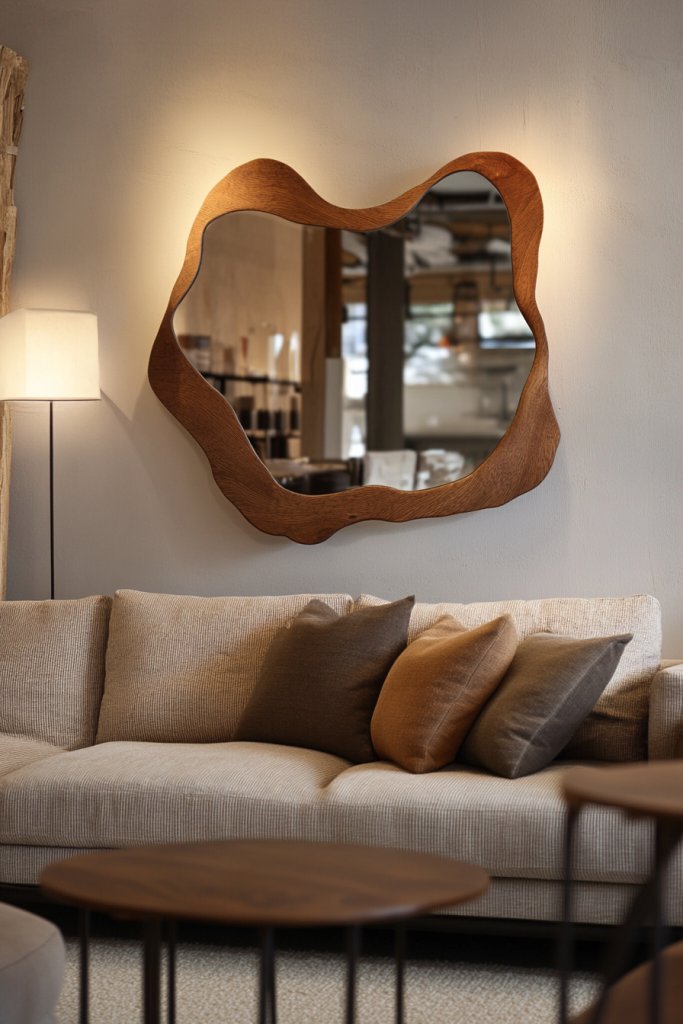
Feeling like your living room’s space is flat or lacks dimension? Mirrors are a simple fix that can make a room appear larger and brighter. But typical rectangular mirrors can feel cold or impersonal. Organic-shaped mirrors add a soft, natural touch while enhancing light and depth.
Imagine a large, freeform mirror with a gentle, flowing edge hanging above your sofa. The mirror’s irregular shape reflects light beautifully, bouncing it around the room and creating a sense of openness. Its organic form echoes natural elements and adds a sculptural element to your decor. The reflection of textured walls or cozy textiles further amplifies the inviting atmosphere.
Choose mirrors with frames in natural materials like wood or rattan, or opt for frameless designs that emphasize the organic shape. Hang multiple mirrors in different sizes for a gallery wall effect. Use them strategically near light sources or windows to maximize brightness. Incorporate mirrors into your decor as statement pieces or subtle accents.
Select mirrors with irregular, organic borders or sculptural shapes that complement your decor. Mount them securely at eye level, considering wall anchors for heavier pieces. Position mirrors opposite windows or light fixtures to reflect maximum light. Balance their placement with other natural textures and materials.
Personalize by choosing frames in natural finishes or painting them in muted hues. Incorporate textured or beveled edges for added visual interest. Use them to reflect beautiful vignettes, like a sculptural vase or textile arrangement. Update positioning seasonally for fresh perspectives.
Organic-shaped mirrors bring a touch of nature and artistry into your space. They brighten and expand the room without overwhelming it. With a little creativity, these mirrors help craft a harmonious, organic aesthetic that feels both fresh and timeless.
14. Create a Calm, Clutter-Free Layout with Simple, Functional Furniture for Natural Flow

Does your living room feel chaotic or crowded? Clutter hampers the flow and makes the space less relaxing. A calm, clutter-free layout with simple, functional furniture promotes peace and easy movement. It’s the foundation for an organic modern aesthetic that feels natural and effortless.
Visualize a layout with a low-profile sofa, a sleek coffee table, and unobstructed pathways. Keep surfaces clear of unnecessary items, opting for hidden storage or baskets. The furniture’s clean lines and neutral colors allow textures and natural materials to shine. The open arrangement invites you to relax and breathe.
Choose streamlined furniture with simple shapes and natural finishes. Prioritize pieces that serve multiple purposes—like storage ottomans or extendable tables. Keep accessories minimal and organized to avoid visual clutter. Adjust your layout seasonally or for different activities, always maintaining a sense of flow.
Start with a floor plan that emphasizes openness. Use furniture with thin legs or floating designs to create a sense of space. Incorporate hidden storage to keep clutter out of sight. Keep surfaces tidy with baskets or trays for daily essentials. Regularly declutter to sustain the calm environment.
Add personal touches with textured cushions or simple decorative objects. Use multi-functional furniture with natural or matte finishes. Incorporate flexible pieces like lightweight chairs or modular units. Maintain a neutral palette to keep the overall look serene and balanced.
A well-organized, uncluttered living room promotes mental clarity and peace. It’s about creating a space that supports your lifestyle and well-being. With thoughtful design choices, your space will become a sanctuary of natural flow and effortless style.
Conclusion
Exploring these diverse organic modern living room ideas shows just how versatile and inviting this design style can be. From cozy seating arrangements to eco-friendly decor touches, there’s plenty of inspiration to transform your space into a natural haven. Embrace these ideas, experiment with different elements, and create a living room that reflects your love for comfort and nature—your perfect sanctuary awaits!
Leave a Reply